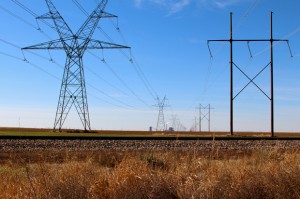State Agencies Concerned About Carrying Out EPA’s ‘Aggressive’ Air Pollution Plan
-
Joe Wertz

roy.luck / Flickr
Power lines extend out from the Oklaunion coal-fired power plant near Vernon, Texas.
State environmental and utility regulators on Thursday said it would be a struggle to accomplish carbon dioxide reduction goals outlined in the U.S. Environmental Protection Agency’s “Clean Power Plan.”
The EPA’s proposal, first outlined in June, “would mean carbon dioxide reductions of more than 40 percent from Oklahoma power plants by 2030,” The Oklahoman‘s Paul Monies reports:
The Department of Environmental Quality already has 12 employees studying the proposed rules and how they might be implemented in the state, said Eddie Terrill, director of the air quality division.
“I know EPA is on this timeframe they’re on, but I’m not sure it’s realistic,” Terrill said. “This plan is unlike anything we’ve ever done in the past.”
The DEQ’s concerns were conveyed at public meeting organized by Corporation Commissioner Dana Murphy, who also heard from other policymakers, energy and utility industry representatives and environmental groups.
If Oklahoma doesn’t come up with its own air pollution reduction plan, the EPA will likely impose its own, The Journal Record‘s Sarah Terry-Cobo reports. Electricity generators are worried about the cost of compliance:
In addition, the Southwest Power Pool will also likely work with utilities if companies decide to change how they generate electricity. The regional transmission organization isn’t bound by environmental rules, however. It’s obligated to help its members work together to provide reliable electricity and plan for future supply and demand.
Other states are struggling to address the EPA’s proposals, currently in the comment period, which the federal agency expects to finalize by June 2015. Oklahoma Attorney General Scott Pruitt recently joined his counterparts in 11 other states in a lawsuit that challenges the EPA’s proposed carbon dioxide rules for existing power plants, Monies reports.
As backdrop to the EPA’s proposed pollution rules, the federal government in May bluntly warned every region of the United States is already observing climate change-related environmental and economic effects.
The National Climate Assessment warned that carbon emissions are increasing energy and water demand, changing crop growth cycles and rainfall patterns in Oklahoma and other Great Plains states.
